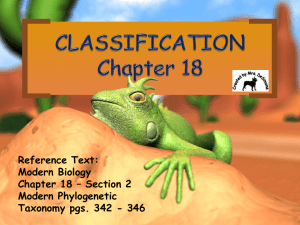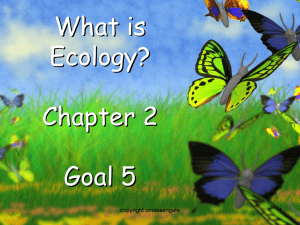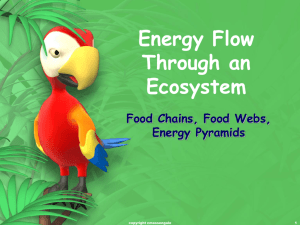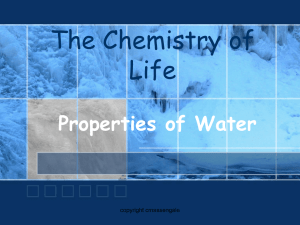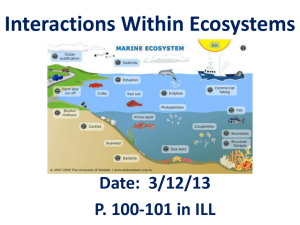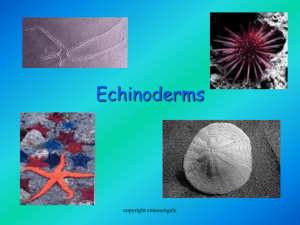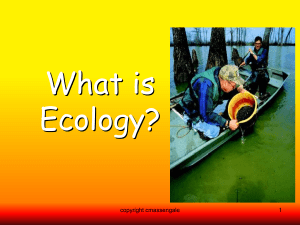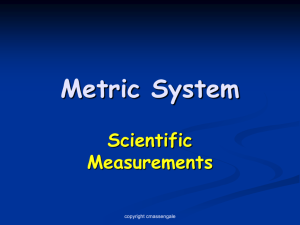Introduction to Biology Presentation
advertisement
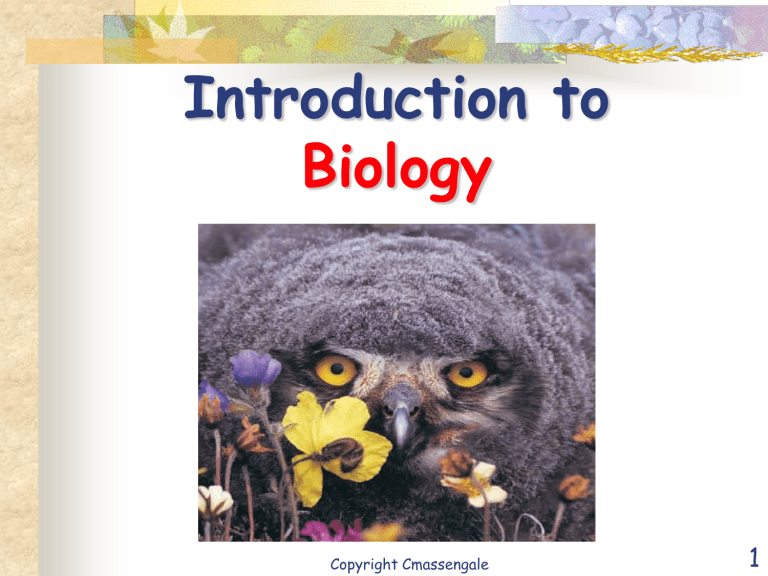
Introduction to Biology Copyright Cmassengale 1 Biology – The Study of Life Life arose more than 3.5 billion years ago First organisms (living things) were single celled Only life on Earth for millions of years Organisms changed over time (evolved) Copyright Cmassengale 2 New organisms arose from older kinds Today there are millions of species They inhabit almost every region of Earth today Copyright Cmassengale 3 Themes of Biology Cell structure and function Stability and homeostasis Reproduction and inheritance Evolution Interdependence of organisms Matter, energy, and organization Copyright Cmassengale 4 Cell Structure and Function Cell basic unit of life All organisms are made of and develop from cells Some composed of only a single cell (unicellular) which is usually identical to parent Copyright Cmassengale 5 Cells Most organisms are composed of many cells (multicellular) Cells are different (undergo differentiation) Cells are small Cells are highly organized Copyright Cmassengale 6 Cells contain specialized structures (organelles) that carry out the cell’s life processes Many different kinds of cells exist All cells surrounded by a plasma membrane Contain a set of instructions called DNA (genetic information) Copyright Cmassengale 7 Stability and Homeostasis Organisms must Maintain very stable internal conditions HOMEOSTASIS Temperature, water content, chemical content, etc. must be maintained Copyright Cmassengale 8 Reproduction and Inheritance All organisms produce new organisms like themselves REPRODUCE Organisms transmit hereditary information to their offspring INHERITANCE Copyright Cmassengale 9 DNA Genetic Information in all cells Deoxyribonucleic Acid DNA contains instructions for traits GENES Make the structures and complex chemicals necessary for life PROTEINS DNA in every body cell (SOMATIC CELLS) is exactly alike Copyright Cmassengale 10 Sexual Reproduction Hereditary information from two different organisms of the same species are combined Egg and sperm zygote (fertilized egg) Zygote contains hereditary information from both parents Copyright Cmassengale 11 Asexual Reproduction Hereditary information from one, usually unicellular, organism that divides Resulting cells contain identical hereditary information Genetic information from single parent Copyright Cmassengale 12 Evolution Populations of organisms change (evolve) over generations (time) Explains how many different kinds of organisms came into existence SPECIES Explains how modern organisms are related to past organisms Copyright Cmassengale 13 Explains why organisms look and behave the way they do Provides a basis for exploring the relationships among different groups of organisms Copyright Cmassengale 14 Natural Selection Natural selection is the driving force in evolution Organisms that have certain favorable traits are better able to successfully reproduce than organisms that lack these traits Copyright Cmassengale 15 Natural Selection Survival of organisms with favorable traits cause a gradual change in populations over many generations Also Called “Survival of the Fittest” Copyright Cmassengale 16 Interdependence of Organisms Interaction of organisms with one another and with their environment ECOLOGY Insects depend and flowers DEPEND on each other for food & pollination COEVOLUTION Copyright Cmassengale 17 All organisms need substances such as nutrients, water, and gases from the environment The stability of the environment depends on the healthy functioning of organisms in that environment Copyright Cmassengale 18 Matter, Energy and Organization Living things are highly organized Require a constant supply of energy to maintain their orderly state Copyright Cmassengale 19 Energy ALL energy comes from the SUN (directly or indirectly) Photosynthesis is the process by which some organisms capture the energy from the sun (solar) and transform it into energy (chemical) that can be used by living things Copyright Cmassengale 20 Autotrophs Organisms that make their own food are called autotrophs Phototrophs – use solar energy (photosynthesis) to get energy Convert H2O and CO2 into sugar and O2 Chemotrophs – use different chemical processes to get energy Copyright Cmassengale 21 Heterotrophs Organisms that must take in food to meet their energy needs are called heterotrophs Consume autotrophs (herbivores), other heterotrophs (carnivores) or both (omnivores) for their energy needs Complex chemicals are broken down and reassembled into chemicals and structures needed by organisms Copyright Cmassengale 22 The World of Biology Chapter 1.2 Copyright Cmassengale 23 Characteristics of Life Copyright Cmassengale 24 Cells All living things are composed of cells In multicellular organisms, many are specialized to perform specific functions Cells are always very small The size of multicelled organisms depends on the number of cells NOT their size Copyright Cmassengale 25 Organization Organized at both the molecular and cellular levels Take in substances from the environment and organize them in complex ways Specific cell structures (organelles) carry out particular functions Copyright Cmassengale 26 Copyright Cmassengale 27 In multicellular organisms, cells and groups of cells (tissues) are organized by their function Cells tissues Tissues organs Organs systems Systems ORGANISMCopyright Cmassengale 28 Energy Use Use energy in a process called metabolism Sum of all chemical processes Require energy to maintain their molecular and cellular organization, grow and reproduce Copyright Cmassengale 29 Homeostasis Maintain stable internal conditions Temperature, pH, etc. Copyright Cmassengale 30 Growth Grow occurs as the result of cell division and cell enlargement Cell division is the formation of two cells from a preexisting cell New cells enlarge as they mature When a cell grows to a size where its surface area isn’t big enough for its volume, the cell divides Copyright Cmassengale 31 Development The process by which an adult organism arise is called development Repeated cell divisions and cell differentiation Copyright Cmassengale 32 Reproduction All species have the ability to reproduce Not essential to survival of individual but is essential for continuation of a species Copyright Cmassengale 33 Responsiveness Respond to stimuli in the external environment Detect and respond to changes in light, heat, sound and chemical and mechanical contact Coordinates it’s responses Copyright Cmassengale 34 Evolve Ability to adapt to their environment through the process of evolution Favorable characteristics are selected for and passed on to offspring Called adaptations Driven by natural selection or “survival of the fittest” Copyright Cmassengale 35 Scientific Method Chapter 1.3 Copyright Cmassengale 36 Observation – STEP 1 Employing your five senses to perceive objects or events Copyright Cmassengale 37 Asking a Question Based on observations; one or more questions are generated Copyright Cmassengale 38 Forming a Hypothesis – STEP 2 A statement is testable if evidence can be collected that either does or doesn’t support it It can never be proven beyond doubt Often must be refined and revised or discarded Copyright Cmassengale 39 The Hypothesis -- Is a statement made in advance that states the results that will be obtained from testing the hypothesis Often written in the form of an “if-then” statement Copyright Cmassengale 40 Experimenting – STEP 3 Testing a hypothesis or prediction by gathering data under controlled conditions – conducting a controlled experiment Based on a comparison of a control group with an experimental group Copyright Cmassengale 41 Both groups are identical except for one factor (independent variable) Observations and measurements are taken for a particular factor (dependent variable) in both groups Driven by or results from independent variable Copyright Cmassengale 42 Measuring Involves quantitative data that can be measured in numbers &/or qualitative data information that isn’t numbers Sampling Technique of using a sample – a small part – to represent the entire population Copyright Cmassengale 43 Organizing Data – STEP 4 Involves placing observations and measurement (data) in order Graphs, charts, tables, or maps Copyright Cmassengale 44 Analyzing Data – STEP 4 cont) Collected and organized data must be analyzed Process of determining whether data are reliable or whether they support or do not support a hypothesis or prediction Copyright Cmassengale 45 Conclusion – STEP 5 Conclusions are made on the basis of facts, not observations Often drawn from data gathered from a study or experiment Should support the hypothesis Should be re-testable Copyright Cmassengale 46 Communication – STEP 6 Scientists must share the results of their studies with other scientists (peers) Publish findings in journals Present their findings at scientific meetings Scientists must be unbiased Should not tamper with their data Only publish & report tested & proven ideas Copyright Cmassengale 47 Communication Sharing of information is essential to scientific process Subject to examination and verification by other scientists Allows scientists to build on the work of others Copyright Cmassengale 48 Theories A theory may be formed after many related hypotheses have been tested and supported with experimental evidence A broad and comprehensive statement of what is thought to be true Supported by considerable evidence Ties together related hypotheses Copyright Cmassengale 49 Laws A Statement of fact that concisely explains an action or group of actions e.g. Law of Gravity Accepted to be true Universal May be expressed as a math equation e.g. E=mc2 Copyright Cmassengale 50 MICROSCOPES Copyright Cmassengale 51 Microscopy and Measurement Microscopes – produce an enlarged image of an object Used to study organisms, cells, and cell parts Increase in apparent size is called magnification The ability to show details clearly is called resolution Microscopes vary in both magnification and resolution Copyright Cmassengale 52 Copyright Cmassengale 53 Compound Light Specimen mounted on Microscopes a glass slide Must be thinly sliced or very small Pair of lenses Ocular lens (eye piece) Objective lens (nose piece) Can be used to study LIVE specimens Copyright Cmassengale 54 Magnification determined by multiplying power of both lenses Eyepiece 10X times Objective power (20X, 40X…) Highest Maximum magnification is around 1000X Copyright Cmassengale 55 Electron Microscope Transmission EM (TEM) Uses a beam of electrons to produce an enlarged image of very thinly sliced specimen on screen or photographic plate Image focused by magnetic lenses 200,000X magnification Cannot be used to view living specimens Copyright Cmassengale 56 Scanning EM (SEM) 3D image Specimens not sliced for viewing Surface sprayed with fine metal coating Also uses electron beam and fluorescent screen or photographic plates 100,000X magnification Cannot be used to view living specimens Copyright Cmassengale 57 MEASUREMENTS Copyright Cmassengale 58 Measurements We will be using SI units or metric system when possible --- the WHOLE world uses it except us (USA) Copyright Cmassengale 59 Copyright Cmassengale 60 Copyright Cmassengale 61 Copyright Cmassengale 62
